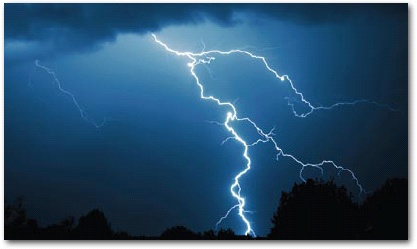Lightning
Catching lightning is tricky. It's not like a portrait, where you can say, "Hey, lemme take one more," or, "Could you move a little to your left?" Lightning tends to be fairly unresponsive to directions from the photographer.
Oh, and then there's that element of danger. Nothing makes you prouder of a shot than knowing you almost got killed taking it.

The first thing you're probably wondering is: "How do they know when the lightning is going to flash?" The answer: They don't. They open the shutter and just let it sit there until lightning happens. Because the sky is otherwise pretty much black, no harm is done; the lightning is the only light that registers on the exposure.
Lightning shots require a tripod and an SLR with a bulb mode, where the shutter can stay open for a long time, and a remote control or cable release (Cable Shutter Release). It also requires some thinking about where you want to set up so you won't be hit by lightning, which can ruin your whole day. For example, you should avoid standing in an open field, near power lines, next to water, atop a hill, and so on.
Use a low ISO. You'll have to experiment with the aperture; ambient light, and the presence of rain (which has a diffusing effect on the lightning's light). The lightning's distance and power also have an effect.
Use a very small aperture, too (a large f-stop number). If you hadn't noticed, lightning ...
Get David Pogue's Digital Photography: The Missing Manual now with the O’Reilly learning platform.
O’Reilly members experience books, live events, courses curated by job role, and more from O’Reilly and nearly 200 top publishers.

